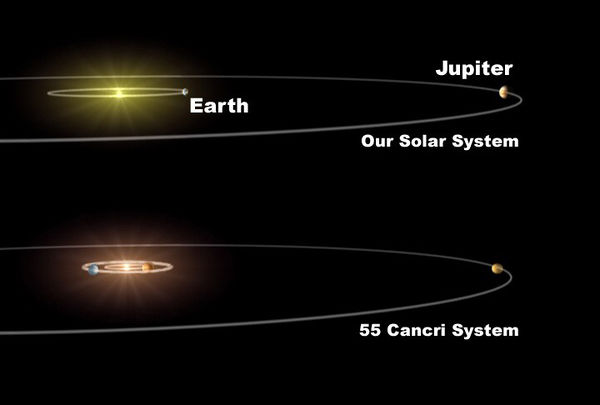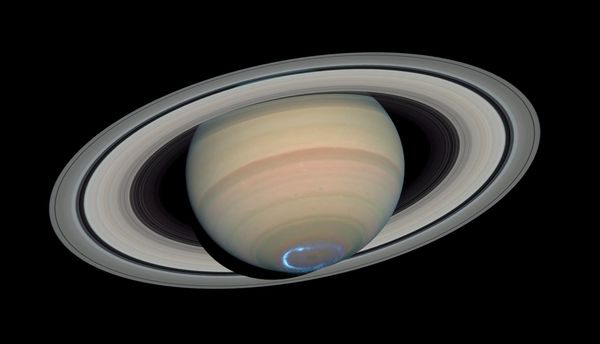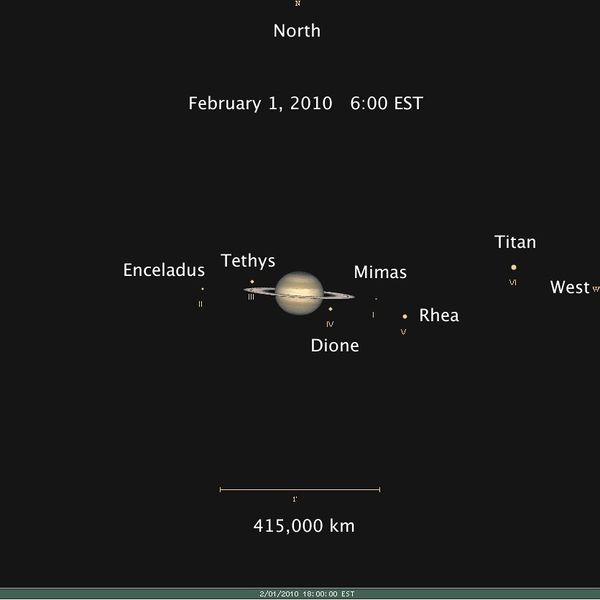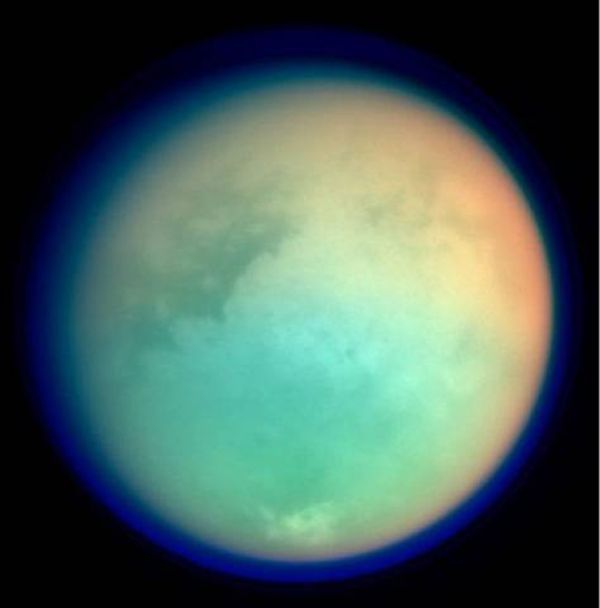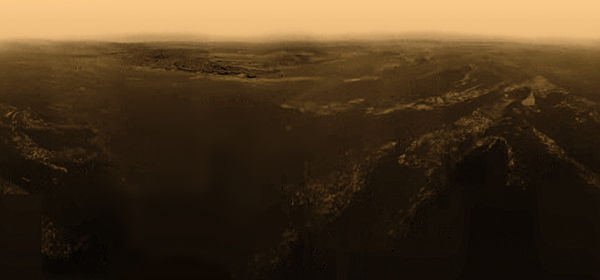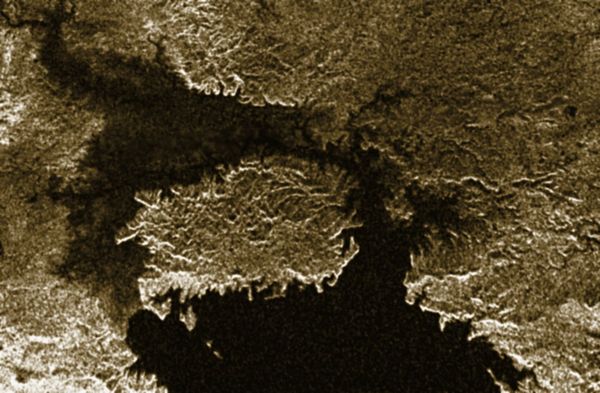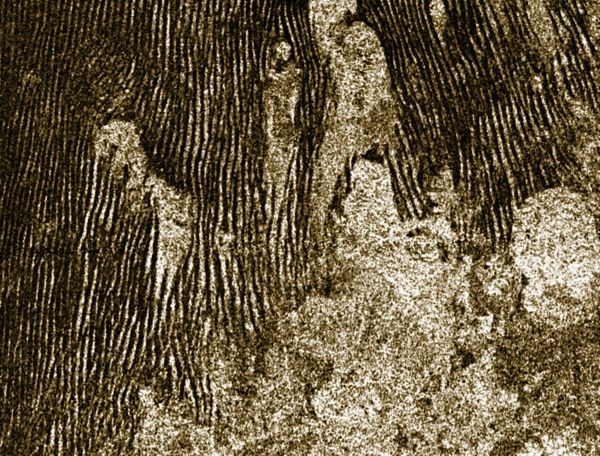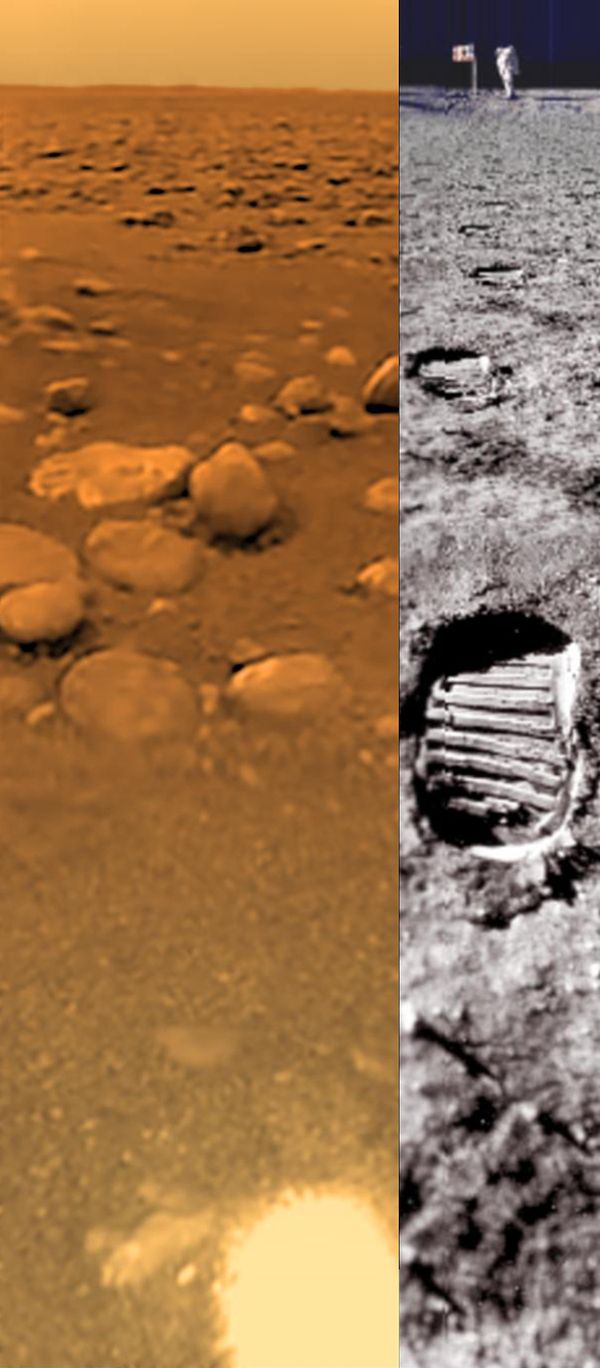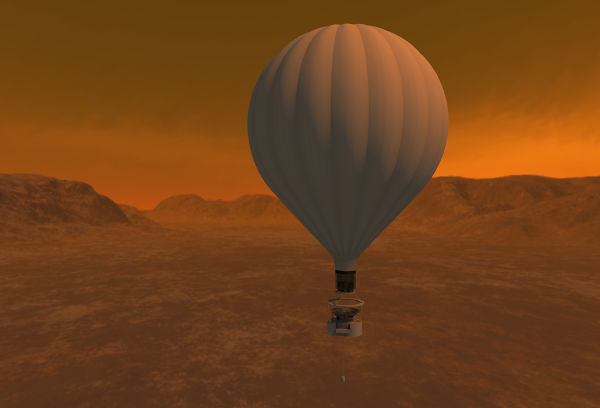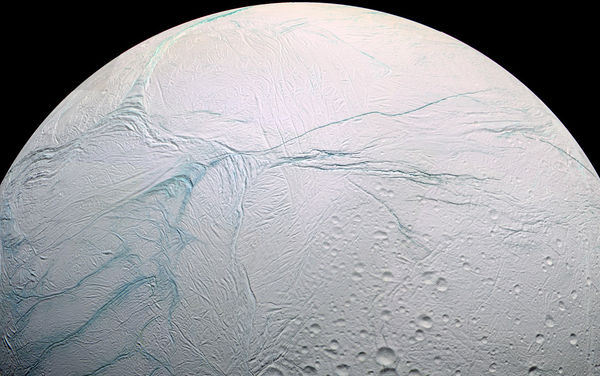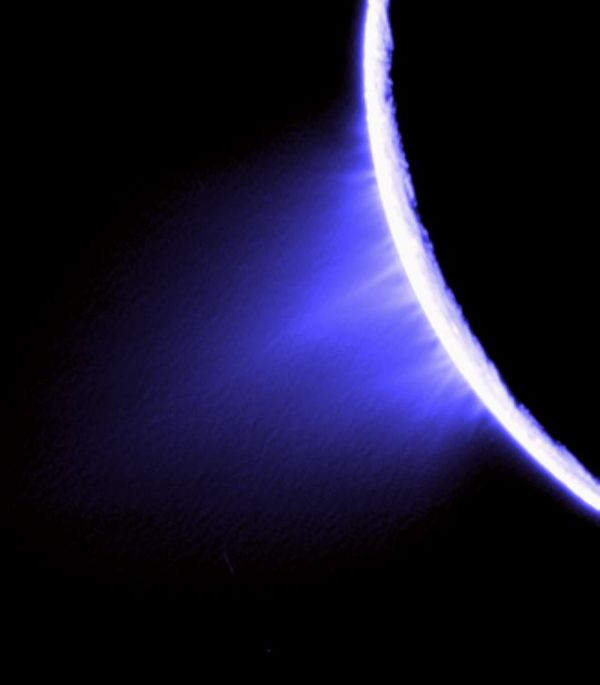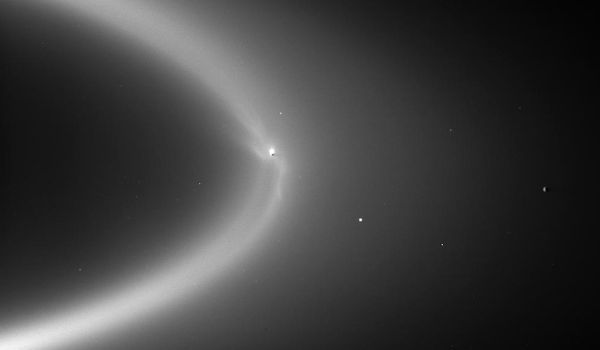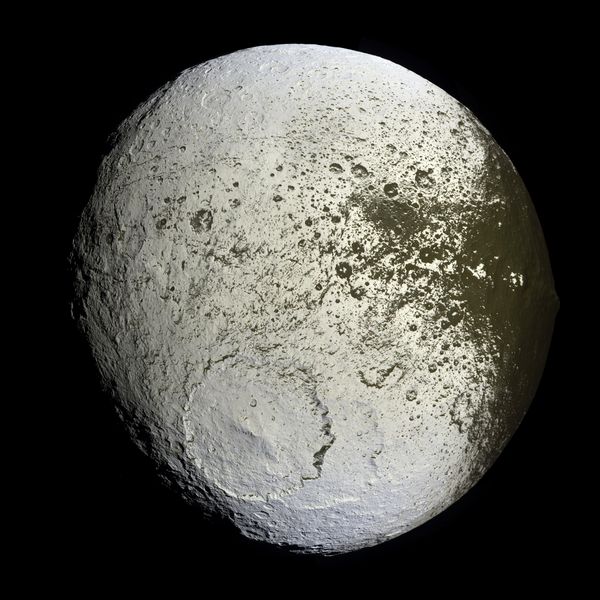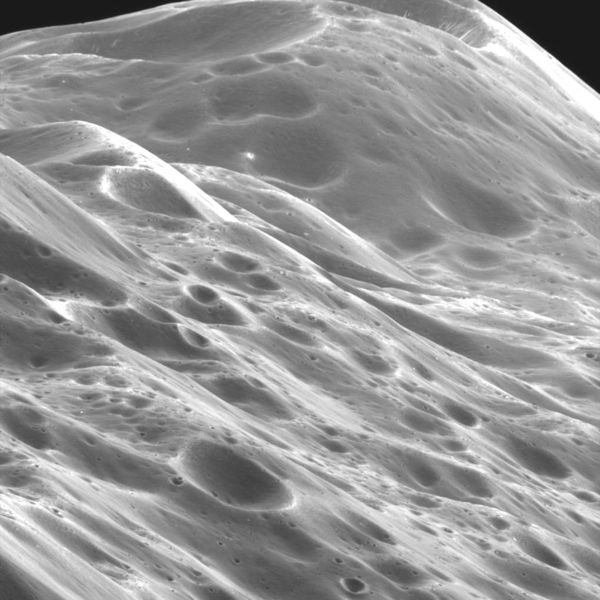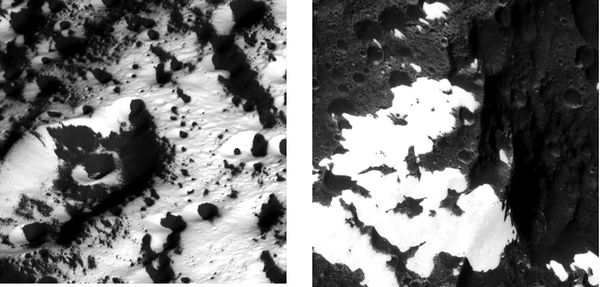Saturn and Extrasolar Planets: Difference between revisions
No edit summary |
|||
| (2 intermediate revisions by the same user not shown) | |||
| Line 1: | Line 1: | ||
<center> | <center> | ||
''''There are more things in | ''''There are more things in heaven and earth, Horatio, Than are dreamt of in your philosophy.'''' | ||
</center> | </center> | ||
<center> | <center> | ||
'''William Shakespeare, Hamlet Act 1. Scene v.''' | '''[http://shakespeare.mit.edu/hamlet/full.html William Shakespeare, Hamlet Act 1. Scene v.]''' | ||
</center> | </center> | ||
| Line 13: | Line 12: | ||
== Extrasolar Planets: Planets Around Other Stars == | == Extrasolar Planets: Planets Around Other Stars == | ||
Exoplanets are planets around other stars. So far, mostly hydrogen/helium gas giants, similar to Jupiter and Saturn, have been found, but there are methods to detect terrestrial planets within habitable zones near some stars. The star 55 Cancri has five confirmed exoplanets, both gas giants and terrestrial. The NASA Kepler Mission is searching thousands of nearby stars for planets. At least a few have been found in an area warm enough to support water-based life. | [http://en.wikipedia.org/wiki/Extrasolar_planet Exoplanets] are [http://exoplanets.org/ planets around other stars]. So far, mostly hydrogen/helium gas giants, similar to Jupiter and Saturn, have been found, but there are methods to [http://www.esa.int/SPECIALS/COROT/SEM7G6XPXPF_0.html detect terrestrial planets] within habitable zones near some stars. The star 55 Cancri has five confirmed exoplanets, both gas giants and terrestrial. The [http://kepler.arc.nasa.gov/ NASA Kepler Mission] is searching thousands of nearby stars for planets. At least a few have been found in an area warm enough to support water-based life. | ||
[[File:extrasolar_planet_nasa2.jpg|600px]] | [[File:extrasolar_planet_nasa2.jpg|600px]] | ||
| Line 37: | Line 36: | ||
An exoplanet might look like Saturn, composed mostly of hydrogen and helium gases, with its own moons, rings, and lovely aurora. | An exoplanet might look like Saturn, composed mostly of hydrogen and helium gases, with its own moons, rings, and lovely aurora. | ||
Powerful lightning, approximately 1000 times that on Earth, streaks through Saturn's thick atmosphere, and hurricanes the size of Earth, with winds as high as 1600 km/h (1,000 mph). Its thick atmosphere gives the planet an average specific density of 0.7 g/cm³. Since water is 1.0, Saturn would float. | Powerful lightning, approximately 1000 times that on Earth, streaks through Saturn's thick atmosphere, and hurricanes the size of Earth, with winds as high as 1600 km/h (1,000 mph). Its thick atmosphere gives the planet an average [http://en.wikipedia.org/wiki/Relative_density specific density] of 0.7 g/cm³. Since water is 1.0, Saturn would float. | ||
Saturn's rocky core is much like the Earth but denser. Above this, there is a liquid metallic hydrogen layer and liquid helium. | Saturn's rocky core is much like the Earth but denser. Above this, there is a [http://en.wikipedia.org/wiki/Metallic_hydrogen liquid metallic hydrogen] layer and liquid helium. | ||
Saturn radiates 2.5 times more energy into space than it receives from the Sun. This comes from gradual gravitational compression, converting helium gas to liquid helium droplets. These fall towards the core, converting potential energy (energy stored in gravity) to kinetic energy (energy in the motion of the gas molecules) . The "temperature" of a gas measures how much energy its molecules have, as they zip around and collide with one another. In these collisions, the movement of the charges inside the atoms and molecules makes the infrared light they emit. | Saturn radiates 2.5 times more energy into space than it receives from the Sun. This comes from gradual gravitational compression, converting helium gas to liquid helium droplets. These fall towards the core, converting potential energy (energy stored in gravity) to kinetic energy (energy in the motion of the gas molecules) . The "temperature" of a gas measures how much energy its molecules have, as they zip around and collide with one another. In these collisions, the movement of the charges inside the atoms and molecules makes the infrared light they emit. | ||
| Line 80: | Line 79: | ||
The Cassini mission has discovered numerous river channels, lakes, islands and mountains on Titan, with radar imaging in close approaches, and with the Huygens probe that landed on the surface on January 14, 2005. | The [http://www.nasa.gov/mission_pages/cassini/main/index.html Cassini] mission has discovered numerous [http://www.youtube.com/watch?v=YJ0hwTzOMPE&feature=related river channels], lakes, islands and mountains on Titan, with radar imaging in close approaches, and with the [http://en.wikipedia.org/wiki/Huygens_probe Huygens probe] that [http://www.youtube.com/watch?v=PJEipHtz3yI&feature=related landed on the surface on January 14, 2005]. | ||
| Line 90: | Line 89: | ||
Hydrocarbon "seas", of methane and ethane look dark in radar.The largest is almost the size of the Caspian Sea or Lake Superior on Earth. | Hydrocarbon "seas", of methane and ethane look dark in radar.The largest is almost the size of the [http://en.wikipedia.org/wiki/Caspian_Sea Caspian Sea] or Lake Superior on Earth. | ||
| Line 146: | Line 145: | ||
These icy jets form towering plumes many kilometers high. Due to the low escape velocity of Enceladus, some leave Enceladus altogether. Geysers on Earth are formed by the steam pressure from water heated where there is magma under the surface. | These icy jets form towering plumes many kilometers high. Due to the low escape velocity of Enceladus, some leave Enceladus altogether. [http://video.google.com/videoplay?docid=5585669172180053070 Geysers on Earth] are formed by the steam pressure from water heated where there is magma under the surface. | ||
| Line 176: | Line 175: | ||
Its 79 day orbit matches its 79 Earth-day long day. So, like Earth's Moon, the same side always faces the planet. Its leading side is dark and its trailing side is white, This suggests the leading side swept up particles of dust. Since dark colors absorb heat, while light colors reflect heat and remain cool, the dark layer on the snowy surface absorbed enough warmth to vaporize the water ice beneath. This water vapor then migrated and froze on the trailing cold side of the moon creating its snowy white surface. | Its 79 day orbit matches its 79 Earth-day long day. So, like Earth's Moon, the same side always faces the planet. Its leading side is dark and its trailing side is white, This suggests the leading side swept up particles of dust. Since dark colors absorb heat, while light colors reflect heat and remain cool, the dark layer on the snowy surface absorbed enough warmth to vaporize the water ice beneath. This water vapor then migrated and froze on the trailing cold side of the moon creating its snowy white surface. | ||
The dark side contains organic compounds similar to the substances found in primitive meteorites and in comets; Earth-based observations have shown these to be carbonaceous, that is carbon based, such as frozen | The dark side contains [http://en.wikipedia.org/wiki/Organic_matter organic compounds] similar to the substances found in primitive [http://en.wikipedia.org/wiki/Meteorite meteorites] and in [http://en.wikipedia.org/wiki/Comet comets]; Earth-based observations have shown these to be carbonaceous, that is carbon based, such as frozen [http://en.wikipedia.org/wiki/Hydrogen_cyanidehydrogen cyanide] [http://en.wikipedia.org/wiki/Polymer polymers]. | ||
There is also a 10 km (6 mile) high ridge near the equator on the dark side of Iapetus (to the right in this image) which remains unexplained. | There is also a 10 km (6 mile) high ridge near the equator on the dark side of Iapetus (to the right in this image) which remains unexplained. | ||
| Line 205: | Line 204: | ||
There are many job opportunities in space missions. Planetary scientists, engineers, technicians, and programmers may spend many years designing, building, and managing one. The Cassini-Huygens mission is a cooperative project of NASA, the European Space Agency (ESA) and the Italian Space Agency. The Jet Propulsion Laboratory, a division of the California Institute of Technology in Pasadena, manages the mission for NASA's Science Mission Directorate, Washington, D.C. The Cassini orbiter and its two onboard cameras were designed, developed and assembled at JPL. The imaging operations center is based at the Space Science Institute in Boulder, Colo. | There are many job opportunities in space missions. Planetary scientists, engineers, technicians, and programmers may spend many years designing, building, and managing one. The Cassini-Huygens mission is a cooperative project of NASA, the European Space Agency (ESA) and the Italian Space Agency. The Jet Propulsion Laboratory, a division of the California Institute of Technology in Pasadena, manages the mission for NASA's Science Mission Directorate, Washington, D.C. The Cassini orbiter and its two onboard cameras were designed, developed and assembled at JPL. The imaging operations center is based at the Space Science Institute in Boulder, Colo. | ||
For more information about the Cassini-Huygens mission, visit http://saturn.jpl.nasa.gov . | For more information about the Cassini-Huygens mission, visit [http://saturn.jpl.nasa.gov http://saturn.jpl.nasa.gov]. | ||
Latest revision as of 04:30, 7 February 2012
'There are more things in heaven and earth, Horatio, Than are dreamt of in your philosophy.'
Extrasolar Planets: Planets Around Other Stars
Exoplanets are planets around other stars. So far, mostly hydrogen/helium gas giants, similar to Jupiter and Saturn, have been found, but there are methods to detect terrestrial planets within habitable zones near some stars. The star 55 Cancri has five confirmed exoplanets, both gas giants and terrestrial. The NASA Kepler Mission is searching thousands of nearby stars for planets. At least a few have been found in an area warm enough to support water-based life.
The 55 Cancri system compared to our Solar System
We need look no further than our own solar system to see how strange these gas giants and their moons may be.
Saturn: A Gas Giant Planet Around Our Star
Image made by the Hubble Space Telescope taken in ultraviolet light
An exoplanet might look like Saturn, composed mostly of hydrogen and helium gases, with its own moons, rings, and lovely aurora.
Powerful lightning, approximately 1000 times that on Earth, streaks through Saturn's thick atmosphere, and hurricanes the size of Earth, with winds as high as 1600 km/h (1,000 mph). Its thick atmosphere gives the planet an average specific density of 0.7 g/cm³. Since water is 1.0, Saturn would float.
Saturn's rocky core is much like the Earth but denser. Above this, there is a liquid metallic hydrogen layer and liquid helium.
Saturn radiates 2.5 times more energy into space than it receives from the Sun. This comes from gradual gravitational compression, converting helium gas to liquid helium droplets. These fall towards the core, converting potential energy (energy stored in gravity) to kinetic energy (energy in the motion of the gas molecules) . The "temperature" of a gas measures how much energy its molecules have, as they zip around and collide with one another. In these collisions, the movement of the charges inside the atoms and molecules makes the infrared light they emit.
Saturn's Moons and Rings
Saturn's axis is tipped about 27 degrees from the plane of its orbit, and most of the time we either look down on the "north" of the rings, or up on the "south". Once every 15 years from Earth we see the rings edge-on, and they seem to almost disappear from view. That happened most recently on September 4, 2009.
Saturn's rings change appearance as it orbits the Sun
Saturn and some of its moons, as it appeared in February 2010. The horizontal line is a little larger than the distance from Earth to the Moon.
Titan
Saturn's largest moon, Titan, 5150 km in diameter and half again larger than our Moon, orbits far from Saturn.
Unlike other moons, Titan has a heavy opaque atmosphere, with pressure 1 1/2 times that on Earth, similar to the pressure at the bottom of a swimming pool. The air is so thick that, in the 1/5th Earth gravity, people could attach wings to their arms and fly through the air.
The atmosphere's is mostly nitrogen, as is Earth's, with other trace elements, but not enough oxygen to support life as we know it. So far from the Sun, Titan is also very cold, 93.7 K (−179.45 °C) like a frigid desert, with methane-ethane lakes, rocky terrain, mountains, lightning in the thick clouds, and rippling sandy dunes created by high winds.
Titan taken by the Cassini spacecraft in a flyby on October 26, 2004. The image uses infrared and ultraviolet to penetrate the thick , opaque atmosphere, and is shown in false color.
Credit: NASA/JPL/Space Science Institute
The Cassini mission has discovered numerous river channels, lakes, islands and mountains on Titan, with radar imaging in close approaches, and with the Huygens probe that landed on the surface on January 14, 2005.
Mountains seen in infrared light by the Huygens probe, 2 km (1.2 mi) altitude, while landing on Titan
(Credits: ESA/NASA/JPL/University of Arizona, processed by Christian Waldvogel)
Hydrocarbon "seas", of methane and ethane look dark in radar.The largest is almost the size of the Caspian Sea or Lake Superior on Earth.
Titan's lakes of methane and ethane seen by Cassini's radar in February 2007
Credit: NASA/JPL
There are also wavy, sandy dunes.
Wavy dunes wrap around bright mounds on Titan in this Cassini radar image
Credit: NASA/JPL
and "rocky" surfaces. The rocks are probably made of water ice.
Titan's surface seen from the Huygen's lander is on the same scale as this image of Earth's Moon
Planetary scientists, trying to decide the destination for their next big mission, are thinking of surveying the surface of Titan by sending a balloon to float around Titan's thick atmosphere.
ESA, The European Space Agency, is proposing a 10-year study of Titan which will include the use of balloons
Two More Strange Moons of Saturn
Enceladus
Enceladus, a mere 500 km in diameter, is only 1/7th the diameter of our Moon. It is relatively close to Saturn. Although its white icy surface reflects almost 100% of the Sun's light, beneath the surface tidal forces from Saturn's gravitational pull provide sufficient heat to create liquid water reservoirs that erupt in geysers. These jets spurt ice particles, water vapor and trace organic compounds, which have created a ring in Enceladus' orbit. There is speculation the water could harbor life in a satellite such as Enceladus, or Jupiter's Europa.
Fissures in Enceladus' south pole (to left) send out geysers
These icy jets form towering plumes many kilometers high. Due to the low escape velocity of Enceladus, some leave Enceladus altogether. Geysers on Earth are formed by the steam pressure from water heated where there is magma under the surface.
Cassini image of Enceladus' geyser plumes (false color)
Cassini spacecraft's Ultraviolet Imaging Spectrograph detected four high-density gas streams composed of water vapor. These geysers shoot out from Enceladus, leaving a trail, which has formed a thin nebulous ring around Saturn.
Enceladus in "E" ring of Saturn which is created mostly by its water geysers
Euceladus' thin nebulous ring around Saturn is just outside the bright rings
Iapetus
Iapetus , 1436 km in diameter, is twice as far from Saturn as Titan. Iapetus is a strangely two-tone planet in this bird's view.
Its 79 day orbit matches its 79 Earth-day long day. So, like Earth's Moon, the same side always faces the planet. Its leading side is dark and its trailing side is white, This suggests the leading side swept up particles of dust. Since dark colors absorb heat, while light colors reflect heat and remain cool, the dark layer on the snowy surface absorbed enough warmth to vaporize the water ice beneath. This water vapor then migrated and froze on the trailing cold side of the moon creating its snowy white surface.
The dark side contains organic compounds similar to the substances found in primitive meteorites and in comets; Earth-based observations have shown these to be carbonaceous, that is carbon based, such as frozen cyanide polymers.
There is also a 10 km (6 mile) high ridge near the equator on the dark side of Iapetus (to the right in this image) which remains unexplained.
Iapetus
Part of the 10 km (6 mile) high ridge on the dark side of the Iapedus
Snowy water ice on Iapetus amidst its craters
Credit: NASA/JPL
Jobs in Space
There are many job opportunities in space missions. Planetary scientists, engineers, technicians, and programmers may spend many years designing, building, and managing one. The Cassini-Huygens mission is a cooperative project of NASA, the European Space Agency (ESA) and the Italian Space Agency. The Jet Propulsion Laboratory, a division of the California Institute of Technology in Pasadena, manages the mission for NASA's Science Mission Directorate, Washington, D.C. The Cassini orbiter and its two onboard cameras were designed, developed and assembled at JPL. The imaging operations center is based at the Space Science Institute in Boulder, Colo.
For more information about the Cassini-Huygens mission, visit http://saturn.jpl.nasa.gov.
